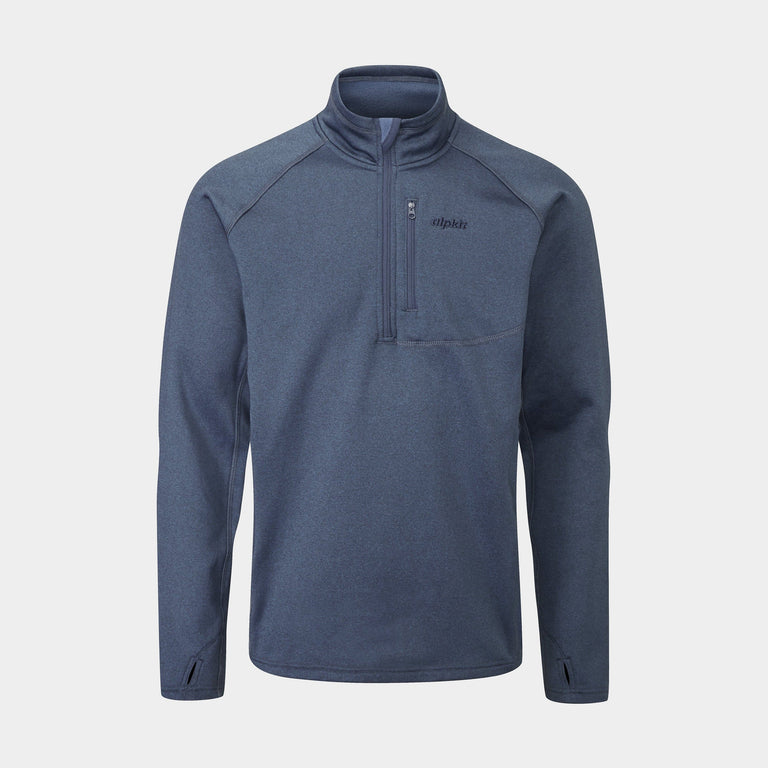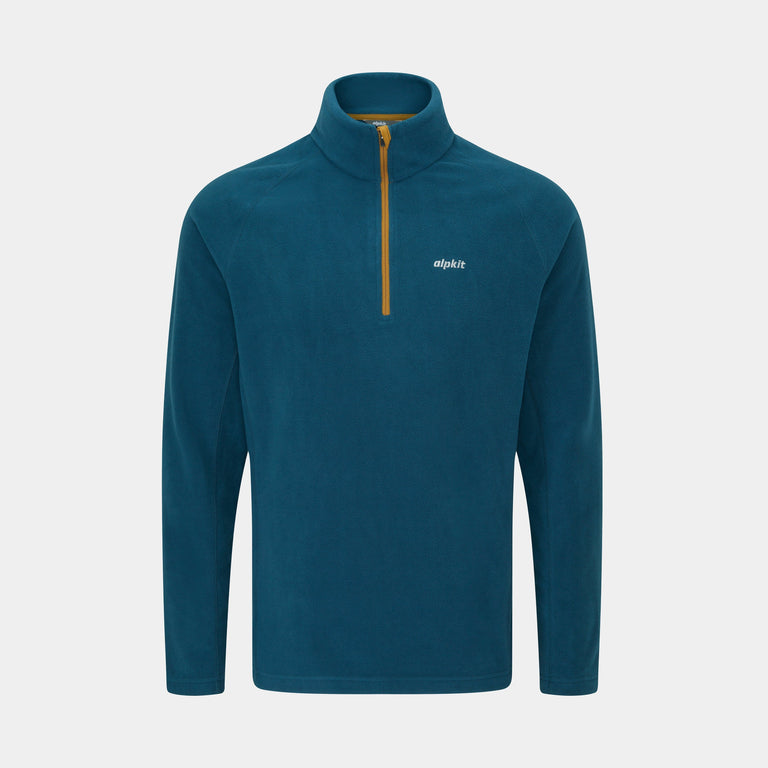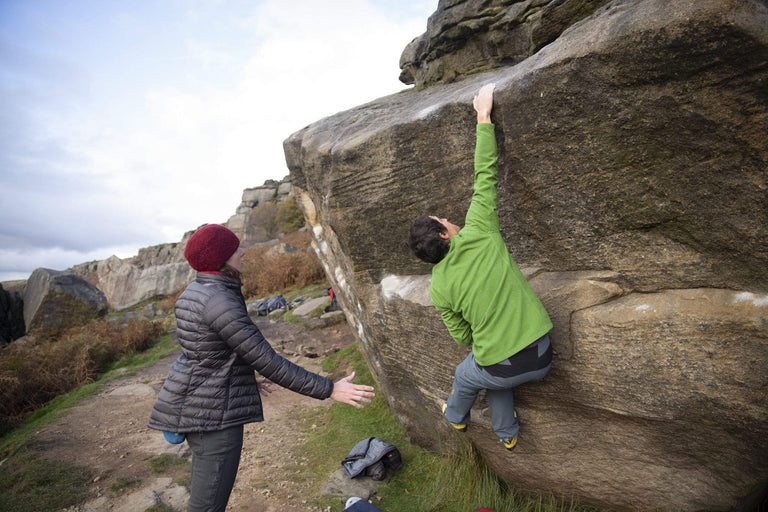
Learn how fleece really performs as a mid-layer. Practical advice on warmth, breathability and finding the right option for your adventures.
If you could only own one piece of outdoor clothing beyond the basics, make it a good fleece. Here’s why, and how to choose the perfect one.
Quick Start: Fleece Guide
New to fleece? Start with What Makes Fleece Special?
Finding your type? Jump to Fleece Categories: Finding Your Perfect Match
Activity-specific needs? Go to Matching Fleece to Your Adventures
Choosing features? Skip to Key Features Decoded
The Swiss Army Knife of Outdoor Clothing
The scene is set: you start hiking in the early morning chill, warm up as the sun rises, get caught in a brief shower, and then face a cold wind at the summit. Through all these conditions, there is one piece of clothing that doesn’t leave your back. It adapts and keeps working – It’s your midlayer.
Fleece is the most common type of midlayer. Usually made out of polyester it comes in a varieties of weights, textures and finishes.
If you want to cut down on the plastic in your life there are natural fibre alternatives, with wool being the obvious choice.
The midlayer could be the most versatile piece in your outdoor wardrobe. It works as outerwear in mild conditions, insulation in a layering system and just your plain old jumper when you are off the hill.
What Makes Fleece Special?
The Performance Sweet Spot
Fleece occupies a unique position in outdoor clothing:
- Warm but breathable – insulates without overheating
- Works when wet – retains most of its warmth even when wet
- Dries quickly – back to full performance fast
- Incredibly durable – lasts for years of hard use
- Easy care – throw it in the washing machine
- Always ready – no special storage requirements
The Science Made Simple
Modern fleece fabrics trap air in their structure while allowing moisture to move through. Think of it as engineered wool – synthetic fibres woven to create thousands of tiny air pockets that provide insulation while letting your body’s moisture escape.
Fleece Categories: Finding Your Perfect Match
Active Fleeces: For When You’re Moving
Best for: Hiking, trail running, cycling, climbing
Key features: Lightweight, highly breathable, packable
When to use: As outer layer in cool conditions or mid-layer in cold weather
Characteristics:
- Thinner construction (150-200gsm typically)
- Grid patterns or mesh panels for extra breathability
- Slim fit that layers well
- Often with thumb loops and fitted hoods - like the Griffon
Perfect scenario: Alpine starts that will warm up, or stop-start activities like rock climbing
Insulation Fleeces: For Maximum Warmth
Best for: Cold weather hiking, camping, static activities
Key features: Thick pile construction, excellent warmth retention
When to use: When temperature is the main concern
Characteristics:
- Thicker, fluffier construction (250-400gsm)
- Focus on warmth over breathability
- Relaxed fit for comfort and layering
- Often with hand-warmer pockets
Perfect scenario: Cold weather hiking, campsite use, or as insulation under a shell
Wind-Resistant Fleeces
Best for: Exposed locations, changeable conditions
Key features: Dense outer face fabric, weather protection
When to use: When you need warmth plus protection from elements
Characteristics:
- Tightly woven outer layer
- Soft fleece interior
- Better weather resistance than standard fleece
- Often treated with DWR for water resistance
Perfect scenario: Windy ridges, light rain, or as a standalone outer layer
Matching Your Fleece to Your Adventures
Let’s see how this plays out in practice with some practical examples.
For Day Hiking and Walking
Your need: Versatile layer that adapts to changing conditions
Best choice: Mid-weight fleece with good breathability
Key features: Full-zip for ventilation control, packable enough for your day pack
For Multi-Day Adventures
Your need: Reliable warmth that’s easy to care for
Best choice: Durable fleece that works in various roles
Key features: Odour resistance, robust construction, versatile fit
For High-Intensity Activities
Your need: Breathable warmth that won’t overheat you
Best choice: Lightweight, active-cut fleece
Key features: Excellent moisture management, freedom of movement
For Cold Weather Specialists
Your need: Maximum insulation for harsh conditions
Best choice: High-loft fleece with weather resistance
Key features: Thick insulation, wind protection, hand warmers
Key Features Decoded
We threw in a few technical terms there. Don’t get hung up on them but understanding what they mean will help you choose between the thousands of fleeces out there.
Fabric Weight (GSM - Grams per Square Meter)
This simply tells you how many grams a square metre of the fabric would weigh. The lower the weight the finer it will be and generally less insulative. This isn’t always the case as the weave of finish of the fabric will also have an effect - a brushed surface for example will trap more air.
- 100-150gsm: Ultra-light, for mild conditions or high activity
- 200-250gsm: Versatile mid-weight, the sweet spot for most people
- 300gsm+: Heavyweight, for serious cold or static use
Construction Types
This can have a big effect on the look, feel and performance of the garment. Modern finishes can fine tune the breathability, wind resistance and warmth of specific areas, such as under your arms or around your midriff. This zonal targetting can make midlayer more suitable for the demands of specific activities such as trail runnning, climbing and cycling.
Pile Fleece: Traditional fluffy construction, maximum warmth
Grid Fleece: Geometric pattern, better breathability
Micro Fleece: Smooth surface, wind-resistant, versatile
Sherpa Fleece: Extra-fluffy interior, often with smooth outer
Fit Considerations
More often than not you would buy a midlayer to fit over your baselayer and under your outer layer. It is worth trying this as although your base and mid layers will have a good amount of stretch your waterproof will not.
If your waterproof is a slim fit, and you purchased it for summer use you might feel a little constricting. I did this with my lightweight Gravitas jacket. I bought it to use for summer cycle touring, planning to wear at most a Kepler cycling jersey underneath. Anything more and I am as rigid as a length of wood.
Slim Fit: Better for layering under shells, more packable
Regular Fit: Versatile, works alone or with thin layers underneath
Relaxed Fit: Maximum comfort, room for thick layers
Wool mid layers
Wool makes a great natural fibre midlayer. Coming at it from 2 ends, it could be a heavyweight merino wool baselayer, or a knitted wool jumper.
What ever approach you take you will have a warm, breathable, durable and great looking solution with built in anti-bacterial properties that will last you for years.
Traditional Wool Jumpers for the Hills
For those seeking natural fibre alternatives, our expanded range of pure wool jumpers combines heritage styling with modern performance:
Made in Britain
Supporting local manufacturing and reducing our carbon footprint:
- Pennine (Mens): Made in the UK from undyed British wool. Seamless construction means no rubbing under pack straps during long hill days. Classic fit works as your warm outer layer on crisp mornings or as a midlayer under a shell when the weather turns. The natural, undyed yarn requires minimal processing and celebrates British wool’s authentic colours.
- Iona (Womens): UK-made from British wool in its natural state. Relaxed roll neck fit keeps draughts at bay while the boxy cut layers easily over base layers. Side slits give freedom of movement whether you’re scrambling, hiking or simply tending the campfire. Lower transport miles, local craftsmanship, and decades of durability.
RWS Certified Wool
Animal welfare and land management assured:
- Norge (Mens): Half-zip versatility gives instant temperature control on the move. The moss knit yoke adds breathability where you need it most - across your shoulders and upper back. Classic fit means it works equally well as an outer layer in cool conditions or as a midlayer when the wind picks up. 100% RWS certified pure wool.
- Stora (Womens): Fair Isle pattern brings subtle Scandi style to technical performance. Raglan sleeves offer unrestricted movement for active days, while the slightly boxy fit makes layering effortless. Warm, breathable, naturally antibacterial RWS certified wool in a pattern that adds character without fuss.
- Rago (Womens): Modern boxy fit with contrast moss stitch yoke adds texture and extra breathability. The relaxed cut works beautifully over tees and base layers while maintaining a flattering shape. Hardwearing RWS certified wool that’s built for years of campsite comfort and mountain adventures.
Heritage Favourites
Now in fresh seasonal colours:
- Brenin (Mens): Chunky knit warmth with fitted style for layering. Thick, open knit traps insulating air while remaining breathable under a shell. Ribbed edges prevent draughts creeping in.
- Tryfan (Mens): Fitted chunky knit designed for movement. The stretch of the knit allows unrestricted motion whether you’re reaching for holds or striding across the fells.
Why Choose Wool?
Natural Performance:
- Warm even when damp
- Breathes to prevent overheating
- Naturally odour-resistant (fewer washes needed)
- Temperature regulating
- Durable enough for decades
Sustainability:
- 100% natural and biodegradable
- Renewable (sheep grow more fleece each year)
- UK-made options reduce transport emissions
- RWS certification ensures ethical sourcing
- Needs less washing, saving water and energy
Versatility:
- Works as outer layer or midlayer
- Seamless transition from trail to town
- Heritage style meets technical function
- Built to last and age beautifully
Special Features Worth Having
When aren’t special features worth having! In the context of a layering system they become even more powerful when they are compatible with everything else you are wearing.
Thumb Loops
Keep sleeves in place when layering and prevent your sleeves riding up at the wrists. In practice this could be when you raise your arms over your head climbing, pull on over gloves or stretch out to your handlebars while riding your bike.
Pit Zips
These are the zips underneath your armpits. They are essential for high-activity use and instant temperature control. Scenarios include high intensity activities such as cycling and running and are especially useful if your intensity level keeps changing, allowing you to regulate without stopping to add or remove your layers.
Packability
Even with pit zips there are times when you are going to want to stash away your fleece. It is here the synthetic fleeces have the edge over wool, packing down smaller.
Hood Design
A hood is a great addition to a midlayer, whether on a lightweight running midlayer like the Griffon, or a heavyweight winter midlayer like the Mamalute a hood keeps your neck warm. A well fitting hood will also fit underneath a cycling or climbing helmet.
Low-profile: Fits under helmets, layers well under shells
Full hood: Maximum warmth, weather protection
Pocket Configuration
This might not be your primary consideration but it is surprising how practical little things like pockets can make or break a garment. Zipped side pockets are useful for just about anything, but shift them up a couple of inches and they can be used under a climbing harness. A breast pocket is useful for your keys, AirPods, ski pass, marsupial pockets are great hand warmers and rear pockets are great for stashing your windproof on a bike ride.
Hand warmers: Essential for cold conditions
Chest pocket: Handy for small essentials
Internal security: Valuables when using as outer layer
Our Fleece Philosophy
We design fleeces (and wool jumpers) for real-world versatility:
Sustainability Focus:
- Made from recycled materials where possible
- Built to last years of regular use
- Repairable and recyclable at end of life
Performance Priorities:
- Comfort across wide range of conditions
- Durability for frequent use
- Easy care for travel and regular washing
Cross-over Applications:
- Designs that work across multiple sports
- Features useful for various activities
- Versatile enough for everyday wear
Choosing Your First (or Next) Fleece
I am writing this sat at home in my - you guessed it - fleece. It is a Kelpie to be precise. I haven’t been out all day, but when I do I know I am ready for pretty much everything. Cycling, walking, running - technical clothing that also works in the down time.
The One-Fleece Solution
If you can only have one, choose a mid-weight (200-250gsm) full-zip fleece with:
- Good breathability for active use
- Sufficient warmth for static periods
- Full-zip for versatile temperature control
- Quality construction for longevity
Building a Fleece System
A good layering system will for most people reduce the number of specialist layers you will need in your wardrobe, but there will be times where you can justify a slightly warmer, more breathable or more windproof layer.
Light fleece: For active use, layering, warm weather
Heavy fleece: For cold conditions, static use, camp comfort
Wind-resistant fleece: For exposed conditions, changeable weather
Common Mistakes to Avoid
Of all your layers the midlayer is probably the one where you can get away with pretty much anything - chances are it will work, but if you want it to work effectively put some thought into how it will work with everything else you are wearing. Here are some tip:
Too Heavy for Use: Heavyweight fleeces overheat most people during activity
Wrong Fit: Too tight restricts layering; too loose loses efficiency
Ignoring Breathability: All fleeces aren’t equal – some breathe much better
Style Over Function: Features like pockets and hoods often prove essential
Care and Longevity
Even with special treatments like Polygiene fleeces will need a clean to maintain performance. Wool, although naturally anti-microbial will need a wash from time to time.
Keeping Your Fleece Performing
Washing: Regular washing is fine, use mild detergent
Drying: Air dry or low heat tumble dry
Storage: Doesn’t need special care, just keep it clean
Pilling: Normal with use
Keep your wool midlayer performing
Washing: Regular washing is fine, handwash if possible and use natural soap
Drying: Air dry or low heat tumble dry
Storage: Doesn’t need special care, just keep it clean
Pilling: Normal with use, may need darning
When to repair or replace
Fleeces are incredibly maintenance free, but may need some TLC when:
- Significant areas of worn or damaged fabric
- Zips consistently fail
- It no longer fits your needs or activities
We have Repair Stations in all of our stores around the country. If you cannot get to a store you can send it to us.
The Fleece Advantage
In our experience, fleece offers the best combination of performance, versatility, and value in outdoor clothing. It’s forgiving to use, easy to care for, and works in more situations than almost any other single layer.
Whether you’re planning serious mountain adventures or just want something comfortable for weekend activities, a good fleece will serve you well for years.
How a midlayer will become your new best friend
Morning: Light fleece for the early start
Midday: Stuffed in pack as temperatures rise
Evening: Back on for the cooling descent
Camp: Comfortable layer for cooking and relaxing
Emergency: Reliable backup if other layers fail
Making Your Choice
When it comes to finally making your purchase consider these three questions:
- What’s your primary activity level? (Determines breathability needs)
- What conditions do you face most? (Influences weight and features)
- How will you use it? (Outer layer, mid-layer, or both?)
The best fleece is the one that fits your real-world use patterns, not the one with the most technical specifications on paper.
Next up in our series The Complete Guide to Outdoor Clothing: Things hot up as we insulate you from the cold with down and synthetic insulation.
- The Complete Guide to Outdoor Clothing: Layering Systems That Work
- Base Layer Guide: Merino Wool vs Synthetic Materials
- Mid Layers Guide: Fleece and Natural Fibres
- Insulated Jackets: Down vs Synthetic Complete Guide
- Waterproof Jackets: Your Complete Guide to Staying Dry
- Outdoor Trousers, Shorts and Leggings: Your Complete Guide
- Hiking Socks Guide: Materials, Cushioning, and Fit
- Keeping Your Hands Warm: The Complete Guide to Outdoor Gloves
![Griffon Half-Zip [Womens]](http://us.alpkit.com/cdn/shop/files/griffon-half-zip-womens-2025-sangria_25649184-1e42-4b53-823b-6381036b6f84.jpg?v=1764183256&width=768)
![Griffon Half-Zip [Womens]](http://us.alpkit.com/cdn/shop/files/griffon-3_1b2f4d0b-bae3-4f69-81ac-bb383b2f2af9.jpg?v=1764183256&width=768)
![Griffon [Mens]](http://us.alpkit.com/cdn/shop/files/griffon-mens-2025-nemo_c5a2a28e-108d-408e-8449-f8f0b4b3f82c.jpg?v=1765565844&width=768)
![Griffon [Mens]](http://us.alpkit.com/cdn/shop/files/AW25-Chamonix-JW-4572_1.jpg?v=1765565844&width=768)
![Griffon [Womens]](http://us.alpkit.com/cdn/shop/files/griffon-womens-2025-sangria.jpg?v=1764529248&width=768)
![Griffon [Womens]](http://us.alpkit.com/cdn/shop/files/griffon-3.jpg?v=1764529248&width=768)
![Loki [Mens]](http://us.alpkit.com/cdn/shop/files/loki-mens-2025-spruce.jpg?v=1762889236&width=768)
![Loki [Mens]](http://us.alpkit.com/cdn/shop/files/Loki_AW24_Chamonix_4884.jpg?v=1762889236&width=768)
![Loki [Womens]](http://us.alpkit.com/cdn/shop/files/loki-womens-2025-spruce.jpg?v=1763060010&width=768)
![Loki [Womens]](http://us.alpkit.com/cdn/shop/files/Loki_AW24_Chamonix_4918.jpg?v=1763060010&width=768)








![Kelpie [Womens]](http://us.alpkit.com/cdn/shop/files/womens-kelpie-2024-dusk_98e7b1c6-7c10-4890-b216-ba6589d740c3.jpg?v=1754330479&width=768)
![Kelpie [Womens]](http://us.alpkit.com/cdn/shop/files/womens-kelpie-2024-1.jpg?v=1754330479&width=768)
![Keeshond [Womens]](http://us.alpkit.com/cdn/shop/files/womens-keeshond-2024-outerspace.jpg?v=1764183428&width=768)

![Keeshond [Mens]](http://us.alpkit.com/cdn/shop/files/mens-keeshond-2024-kelp-ADJUSTED.jpg?v=1764183554&width=768)
